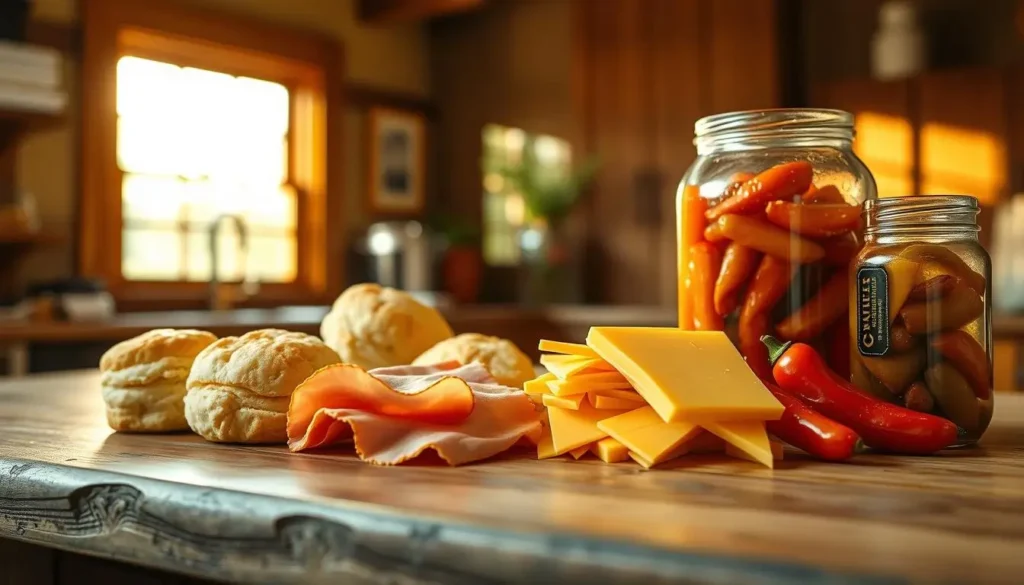You’re going to discover a delicious snack popular throughout the whole United States. A combination of ancient customs and modern tastes, the Alabama Hot Pocket owes much to Southern cuisine. Diving into this culinary treasure will help you understand why it is so adored. The Alabama Hot Pocket is not just food—it reveals the South’s rich history and culture.
Main Points
- Grasping the Alabama Hot Pocket’s relevance in Southern food
- Investigating the cultural identity underlying this unusual meal
- Finding the core of the Alabama Hot Pocket
- Learning about its rising appeal across the U.S.
- Understanding what distinguishes the Alabama Hot Pocket
The Alabama Hot Pocket: A Southern Culinary Legacy
The Alabama Hot Pocket is a meal that reflects the warmth of Southern cuisine. Its past and unusual component combination are well recognized.
Southern Cuisine: Definition and Meaning
The Alabama Hot Pocket is a gastronomic treasure. Its combination of flavors and textures is both gratifying and unique. Wrapped in a crust, its contents are made of meats, cheeses, and seasonings. In Southern cooking, this dish is highly symbolic. It’s considered a sign of warmth and hospitality, showing the heart of Southern cookery.
Historical Background and Source
Southern food history links to the origins of the Alabama Hot Pocket. Though its exact beginning is uncertain, it likely came from robust Southern cuisine. Today, it’s a popular dish known across the country.
Feature Aspect
- Cultural Importance: Reflects regional tastes and ingredients
- Components: Crust, spices, cheese, and meats
- Preparation: Usually fried or baked, inspired by traditional Southern techniques
- Cultural Influence: Represents hospitality and friendliness, essential to Southern culinary identity
What Defines a Genuine Alabama Hot Pocket
Examining its core elements helps us understand what makes a real Alabama Hot Pocket. Though sometimes mocked, it remains a true Southern delicacy. Known for its simple ingredients and quality, it exemplifies classic Southern meals.
Key Components
A real Alabama Hot Pocket uses simple, high-quality ingredients. Wrapped in flaky pastry, the filling includes ground beef, onions, and spices. The flavor and texture rely heavily on ingredient quality.
Conventional Preparation Techniques
Making an Alabama Hot Pocket is simple but detailed. First, brown the ground beef with onions and spices. Then, fold it into the dough and bake or fry until golden.
- Baking results in a crisp pastry
- Frying offers a richer, deeper taste
Perfect Alabama Hot Pocket: A Step-by-Step Guide
Follow this straightforward recipe to craft the perfect Alabama Hot Pocket. This Southern dish requires care, but the outcome is rewarding.
List of Ingredients and Preparation
You’ll need the following:
- 1 lb sliced hot sausage (like Andouille or smoked)
- 1 large onion, chopped
- 2 cloves garlic, minced
- 1 cup white rice
- 2 cups chicken broth
- 1 tbsp olive oil
- Salt and pepper to taste
- 1 tbsp fresh chopped parsley
Start by browning the sausage in olive oil. Set it aside.
Sauté onions and garlic, then add the rice, letting it brown lightly and absorb the oil.
Cooking Directions
In a Dutch oven or saucepan, combine the rice mixture, chicken broth, and browned sausage. Bring to a boil, reduce heat, and simmer covered for 20–25 minutes, until rice is tender.
Season with salt and pepper to taste.
Serving Ideas
Serve hot and garnish with parsley. Pair with a blueberry cottage cheese breakfast bake, green salad, or roasted vegetables for a complete meal.

Common Variations of the Alabama Hot Pocket
New twists on the classic Alabama Hot Pocket have expanded its appeal, showing off its versatility and rich flavor.
Contemporary Takes
Chefs and home cooks add personal flair using different meats and seasonings. For example, spicy chorizo adds boldness.
Cooking methods vary: some grill or bake instead of frying for a healthier version.
Pair with lemon oatmeal no-bake cookies for a sweet contrast.
Regional Variations in the South
Across the South, the Alabama Hot Pocket varies by region. Ingredients like local cheeses or shrimp are common.
Some prefer it crispy, others enjoy a tender texture. These variations reflect the South’s culinary diversity.
Each take highlights different flavors and cooking techniques of the region.
Complementary Dishes and Nutritional Information
Understanding its nutrition and ideal pairings can enhance the Alabama Hot Pocket experience.
Nutritional Insights
Though indulgent, it can be part of a balanced meal. Watch the calories, protein, and fat content. Using leaner meats and less oil helps.
Typical nutritional values per serving:
- Calories: 500
- Protein: 25g
- Fat: 30g
- Carbohydrates: 35g
Recommended Pairings
- Blueberry Cottage Cheese Bake: Light and fruity
- Lemon Oatmeal No-Bake Cookies: Refreshing and healthy
- Strawberry Pretzel Salad: Sweet and salty with a crunchy twist
Final thoughts
The Alabama Hot Pocket is more than a dish—it’s a cultural journey. Full of flavor and tradition, it reflects Southern warmth and hospitality. Whether you’re a first-timer or adding your spin, this dish has something for everyone.
Frequently Asked Questions
What exactly is an Alabama Hot Pocket?
It’s a savory snack with a spicy filling wrapped in dough and baked or fried.
What does “Alabama Hot Pocket” refer to?
A dish from Alabama known for its warmth, bold flavor, and regional roots.
Where did it originate?
In the Southern U.S., likely Alabama, tied to traditional cooking styles.
How do you make a real one?
Use seasoned meat, dough, onions, and cook until golden. Stick to classic ingredients.
What are some common variations?
Some use pulled pork or chicken, different spices, and various cooking methods.
What sides go well with it?
Lemon oatmeal no-bake cookies, blueberry cottage cheese bake, and strawberry pretzel salad.
Is it healthy?
It can be—use lean meat and avoid excess oil to make it lighter.
Can you find it on restaurant menus?
Yes, especially in Southern diners or BBQ joints. Ask locals or check regional spots.

